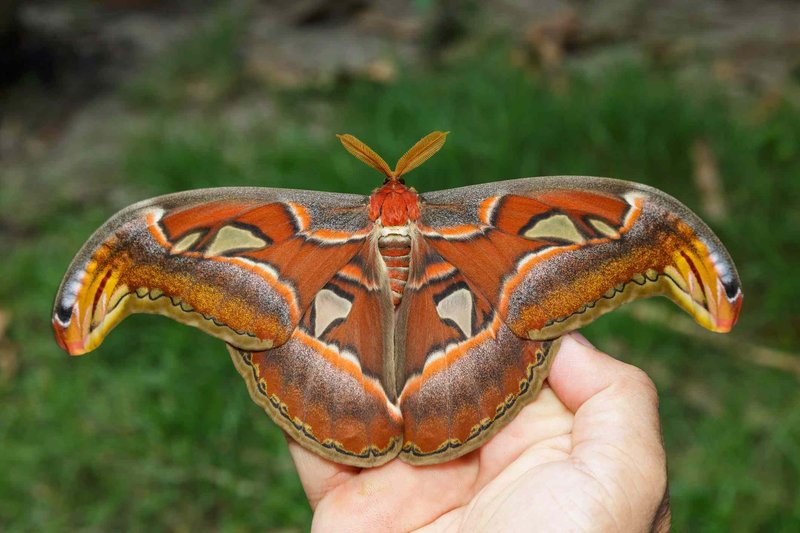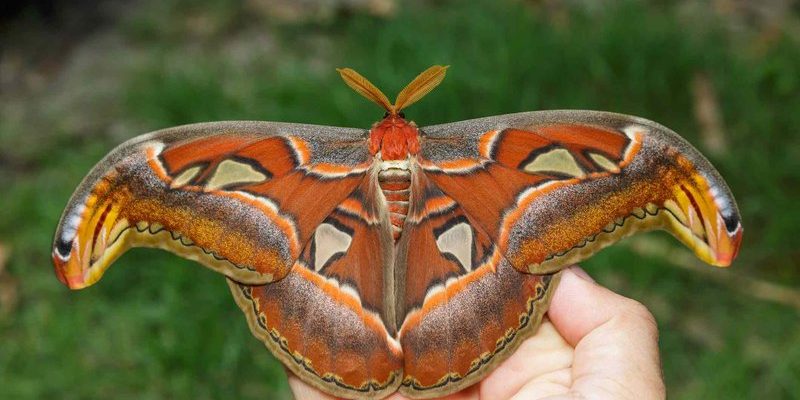
But the Atlas moth isn’t just impressive in size; it also has some fascinating traits and behaviors that completely blow the mind. Whether it’s the way it camouflages itself or how it captivates researchers, the Atlas moth is a wonder of nature. You might be wondering why a moth needs such grand features. Let’s dig into some lesser-known facts about this stunning insect.
1. The Size of a Small Bird
When we talk about the Atlas moth, size is the first thing that usually grabs attention. With a wingspan that can reach up to 10 to 12 inches, the Atlas moth is often considered the largest in the world. To put it in perspective, that’s larger than some birds! This massive size isn’t just for show; it helps the moth intimidate predators. The wings have stunning patterns resembling snake heads, which can scare off potential threats.
But size comes with its challenges. While these moths are impressive in the air, they’re not the best flyers. Their large wings create drag, making it difficult to maneuver quickly. Imagine trying to sprint with a heavy backpack; it’s a bit like that! Instead, they prefer gliding gracefully, often resting on tree trunks or foliage during the day.
2. Short Lifespan: A Month at Most
You might think that something as extraordinary as the Atlas moth would have a long life, but here’s the thing: they only live for about two weeks to a month as adults. Once they emerge from their cocoons, it’s almost like a race against time. Their primary goal during this brief period is to find a mate and reproduce.
Interestingly, adult Atlas moths don’t even eat! They rely on the energy stored in their bodies from their caterpillar stage. Think of it like running a marathon on a full tank—you’ve got what you need to get to the finish line, but you won’t be grabbing snacks along the way. This means they dedicate their entire adult lives to mating and laying eggs, which is why their lifespan is so short.
3. Amazing Camouflagers
One of the coolest things about the Atlas moth is its natural ability to camouflage. The intricate patterns on its wings are designed to mimic the appearance of tree bark or leaves. This makes it almost invisible when resting on a tree. Essentially, it’s a master of hide-and-seek!
This ability isn’t just for fun. It’s a survival mechanism that helps them avoid predators. Think about it: if you can’t see your food, you’re less likely to be eaten. Researchers have even observed that the moths can blend in so well that birds will fly right by them without noticing. It’s like having a superpower!
4. The Caterpillar Stage is Just as Impressive
Before these moths take to the skies, they go through a fascinating caterpillar stage. The caterpillars can grow up to 4 to 5 inches long and are covered in vibrant green skin adorned with small spines for protection. These caterpillars feed primarily on the leaves of certain trees, including the cassava and guava, and can eat quite a lot.
Interestingly, once they are ready to become moths, they spin a cocoon that can take a full week to complete. During this time, their bodies undergo a dramatic transformation. To put it in perspective, it’s like a teen going through their growth spurt—big changes happen, and when it’s over, they’re an entirely different being!
5. Unique Reproductive Rituals
When it comes to mating, the Atlas moth has some unique rituals that add to its mystique. Females release pheromones to attract males from great distances. These scents can travel several miles, drawing the attention of potential mates.
Once a male finds a female, the actual mating process can last up to 24 hours! During this time, they’ll cling together, often hanging from a tree branch. It’s as if they’re in a dance, committed to the rhythm of nature. After mating, the female lays around 200 to 300 eggs on the leaves of their host plants, ensuring their offspring have enough food when they hatch.
6. Native to Tropical Forests
Atlas moths are primarily found in tropical forests across Asia, particularly in countries like Indonesia, Malaysia, and parts of India. These lush environments provide ample food sources for both the caterpillars and adult moths. Living in such biodiverse habitats means they have plenty of predators, too, which is why their camouflage is so important.
However, these stunning moths are facing threats due to habitat loss and deforestation. As more trees are cut down, they lose their homes and food sources. Protecting these natural habitats is crucial if we want future generations to experience the wonder of the Atlas moth.
7. They Don’t Have Mouths as Adults
Here’s a surprising fact about the Atlas moth: adult moths actually don’t have mouths! That’s right. When they emerge from the cocoon, they don’t have the ability to eat. Instead, they rely solely on nutrients stored during their caterpillar stage. This is a big reason why their adult life is so short.
Without mouths, they can’t partake in the feast that many insects enjoy. It’s almost like a party where you can only watch others eat—frustrating, right? Their focus shifts entirely to reproduction during their brief adult phase, which is why they don’t need to consume food.
8. Fascinating Cultural Significance
In some cultures, especially in Southeast Asia, the Atlas moth holds significant cultural value. It’s often featured in art and folklore, symbolizing beauty and transformation. In some regions, locals even use the moth’s wings for decorative purposes, crafting items like jewelry or wall hangings.
Moreover, the moth is sometimes displayed in natural history museums, where its size and beauty captivate visitors. This helps raise awareness about the importance of conservation and the delicate balance of ecosystems. So, when you admire an Atlas moth, you’re not just looking at a beautiful creature; you’re witnessing a symbol of nature’s remarkable diversity.
9. They Have No Feeding Habits
As mentioned earlier, adult Atlas moths don’t eat. This lack of feeding habits is unusual among insects. It’s imperative to understand that this limited lifestyle shapes how they live and interact with their environment. While most insects are busy searching for food, the Atlas moth’s only mission is to mate and propagate the species.
With no eating habits, adult Atlas moths rely heavily on the energy they’ve built up during their caterpillar phase. You can think of it as the ultimate “eat, sleep, mate, repeat” lifestyle, where they have a single focus and no distractions.
10. Conservation Status
Finally, it’s important to talk about conservation. The Atlas moth may be stunning and fascinating, but it is at risk. Habitat destruction due to deforestation and urbanization poses a significant threat to their survival. Thankfully, conservation efforts are kicking in to protect their habitats and raise awareness about their ecological importance.
Organizations are working to preserve tropical forests, ensuring that our planet continues to be a home for these majestic insects. It’s a reminder that every species, no matter how big or small, plays a role in the health of our ecosystem.
As you can see, the Atlas moth is much more than just a large insect. It represents the intricate tapestry of nature, filled with beauty, wonder, and the urgency of conservation. The next time you think about moths, remember the Atlas moth and its incredible story—it’s truly a remarkable creature worth celebrating.

